Americans Traveling to Cuba: The Land of Classic Cars, Cigars, and Rock Climbing!
With warm Caribbean breezes, charming, brightly-colored casitas, salsa dancing, and classic cars from the 1940s rumbling through cobblestoned colonial plazas, you might be wondering if Americans can travel to Cuba. It is after all an exotic Caribbean paradise untouched by Starbucks and McDonalds! Plus there’s the chance to wander through old hotels built by mobster Meyer Lansky, or pull up a bar stool at a swanky locale where Hemingway wrote his Noble Prize-winning works!
However, what made me finally start researching ‘can Americans travel to Cuba’, was when I discovered Cuba has a small but thriving rock-climbing community. In fact, just two hours west of Havana lies a lush, tropical rainforest with some of the best limestone cliffs and overhanging crags in all of the Caribbean!
Yet as an American, traveling to Cuba might be thought of as illegal and unsafe. However, you can travel to Cuba as an American! And in this blog, we’re going to show you how!
We’ve included the following tips for Americans traveling to Cuba:
- Which category you might travel under (you’ll need to fall into one of twelve categories)
- What airlines fly to Cuba
- Best American cities to depart from for Cuba travel
- How to deal with not using your credit card or ATMs
- Where to find wifi or cell service
- But most importantly, how to have the adventure of a lifetime!
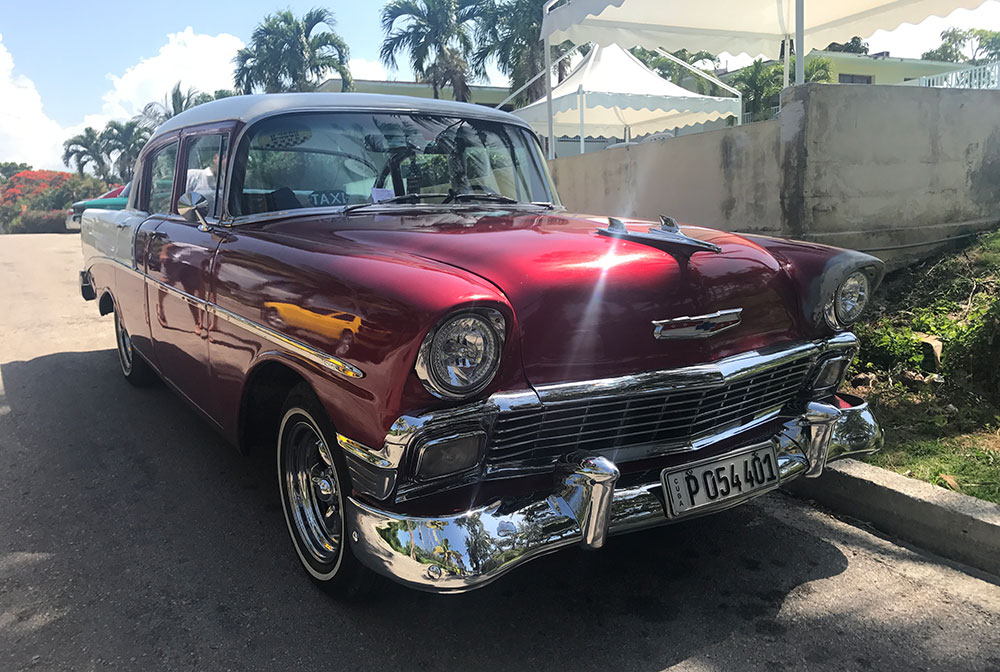
A 1950’s Chevy Bel Air is your typical taxi cab in Havana, Cuba.
Adventure-loving Americans Traveling to Cuba
First, a little different than my other travel blogs, I’m starting with the story of how we got to Cuba as I think you might learn a few things! There I was cruising down the road with my fedora, sunglasses, and the cutest sundress. The Orishas, a Cuban hip-hop group, filled the air. I am surrounded by my adventure-seeking friends.
However, instead of sitting in a 1952 Ford Fairlane on the streets of Old Havana, I began writing this blog while straddling my backpack, crammed in the backseat of a Dodge Charger, and flying across the Everglades from Tampa towards Fort Lauderdale.
Why you might ask did this happen?? Well, we showed up at our gate 59 minutes before our flight and were denied boarding in Tampa. So we rented a car, drove a few hours, and caught the afternoon flight to Cuba out of Fort Lauderdale. Rule number one: Arrive super early for international flights to Cuba!
In order to make your trip to Cuba less, um, eventful, here are some tips:
1. Americans Traveling to Cuba: Flights
Air travel to Cuba from the U.S.
US airlines that fly to Cuba include Southwest Airlines, Jet Blue, and Delta. Most flights will go through Tampa or Fort Lauderdale, and then onto José Martí International Airport in Havana. There are also smaller airports in Cuba, such as Varadero and Santa Clara, however, most airlines from the U.S. will fly into Havana.
We booked with Southwest Airlines, however, we had to book round-trip tickets to Florida, then separate round-trip tickets to Havana. In addition, there are direct flights to Havana from Houston, Miami, Tampa, Fort Lauderdale, or New York’s JFK or Newark airport.
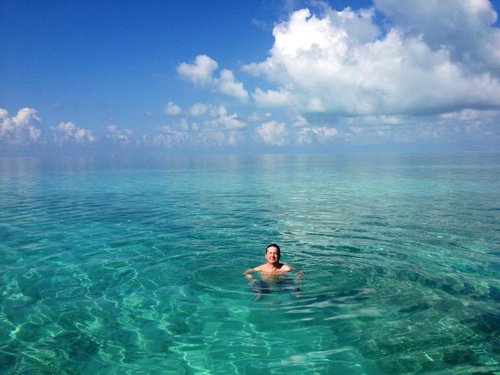
Did you know Cuba is also a great destination for snorkeling and scuba diving?
Tips For Check-In And Packing for your Cuba trip
For Americans traveling to Cuba, arrive at least 2 hours before your departure time. It doesn’t matter if you are an A-list member or a Platinum Superstar team member. Also, do not expect to use the kiosks to check in, and forget about checking in online. You will most likely need to go to a special counter for Cuba flights once you arrive at the airport. In our case, this counter closed 60 minutes prior to departure. Again, just get there early.
Be prepared to pay $50-$85 per person for your visa. Your Cuban visa, along with all travel documents needed for Cuba, can be acquired at the airport counter or in advance through your airline. Have your passport ready, and be prepared to provide your reason for traveling to Cuba. As we were donating rock climbing gear on this trip, we made the trip to support the Cuban people.
Here are the 12 categories that Americans must select from when traveling to Cuba:
- Family visit
- Official government visit
- Journalistic activity
- Professional research or meetings
- Educational activities
- Religious activities
- Public performances, clinics, or workshops
- Athletic competitions or exhibitions
- Support for the Cuban people
- Humanitarian projects
- Activities of private foundations or institutes
- Exportation, Importation, or the transmission of information materials
Pack light. This is the Caribbean after all. You will not need more than a sweatshirt or jacket during your trip to Cuba, even if you plan to head to more mountainous areas like Viñales in the wintertime. And even in fancy Cuban hotels, like Hotel Inglaterra, or popular restaurants, like Floridita, shorts, and flip-flops are the norm.
Do not bring a drone. Do not bring walkie-talkies. Yes, my outdoor adventure-loving friends were traveling with both! There are actually a lot of items that are prohibited or considered weapons in Cuba. Best to leave the fancy equipment at home anyways!
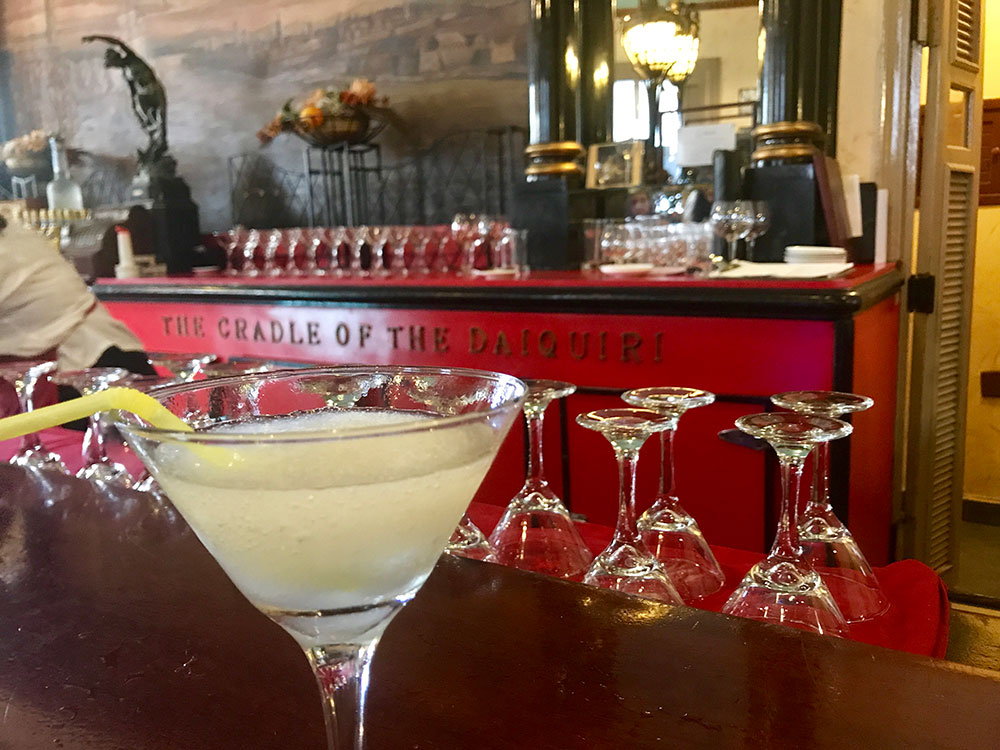
Cuba is the home of the Daiquiri, and La Floridita is one of the best places to enjoy it!
2. Wi-Fi And Phone Service in Cuba
As an American traveling in Cuba, do not depend on international phone service and internet access. One of our friends was excited to have CubaCel service when we landed. However, two days into our trip, he received a call from AT&T that his roaming charges were nearing $700!!
Therefore, even if you have an international plan for your mobile phone, check with your U.S. carrier to ensure they have a contract with ETECSA in Cuba. And confirm what you should expect to pay before departure.
The best bet is often to leave your phone in airplane mode, and/or turn off cellular data to restrict all data to wi-fi, including texts, email, and web browsing.
The good news, there are wi-fi parks and hot spots! As your taxi brings you into town, you will notice lots of local Cubans sitting in parks on their cell phones. This is because there is no internet access at home. Cuba’s national telecom company, ETECSA, instead provides internet access in most major hotels and in wi-fi hotspots across the country.
To log on, first purchase a wi-fi card, basically a piece of paper with a username and password on it, from a local bodega. Keep in mind, most of your apps will not work the way they do in the U.S. And do not expect to be booking an Uber or Lyft ride in Cuba anytime soon!
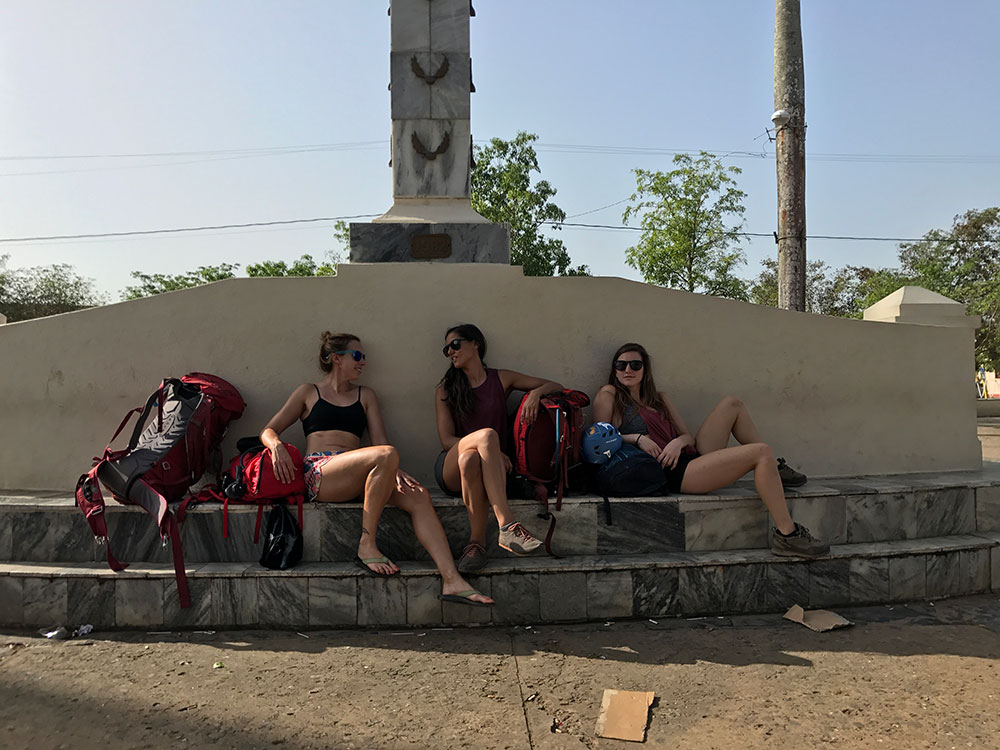
Pack light and use the parks to find transportation, connect to the internet, or just seek out the shade when traveling in Cuba!
3. Americans Traveling in Cuba: Transportation
Americans are so used to renting a car when traveling. However, you will not need a rental car in Cuba! We were able to arrange transportation into Havana easily with one of the many brightly-colored old school ‘taxis’ parked outside of José Martí International Airport. These vintage American cars have been restored to greatness here in Cuba despite having an ongoing trade embargo in place since the 1960’s! And owning one is like a badge of honor.
Other options? Ask your host or hotel concierge to book transportation for you. Even with five people and large backpacks filled with rock climbing gear, we always found it easy to coordinate a ride to the next town!
Be prepared to sweat into the oldies! Do not expect air-conditioning in your vintage 1952 Buick Roadmaster or your 1958 Chevy Bel-Air. Open the windows and enjoy the breeze. However, if air-conditioning is a must, Cuba does have newer cars and shuttle vans with AC available upon request.
4. Finding Accommodations in Cuba
There are plenty of hotels in the major tourist areas of Old Havana, Trinidad, and Varadero (think Cancún style beach resorts). However, you will need to make reservations for accommodations in Cuba before leaving the U.S. In addition, you may not be able to book using apps like AirBnB while in Cuba. We had trouble with this, and had to message a friend in the U.S. to book our last two nights for us!
Keep in mind, most of your phone apps will not work as they do in the U.S., even when connected to wifi.
As an American traveling in Cuba, you will get to know the people and culture if you stay at a Casa particulares. Cubans are becoming more entrepreneurial and are using their homes to host visitors. These are known as casa particulares and we booked in advance through Airbnb! You can book exactly like you would when traveling anywhere else. Features like Instant Booking and Superhosts are available, and we poured through reviews before selecting our homes in three different cities.
Typically you can reserve a hotel or your casa particulares online, and pay cash upon arrival. Bring extra cash (to exchange for Cuban dollars at the airport) if you plan to do this. More on exchanging American dollars for Cuban pesos in a bit!
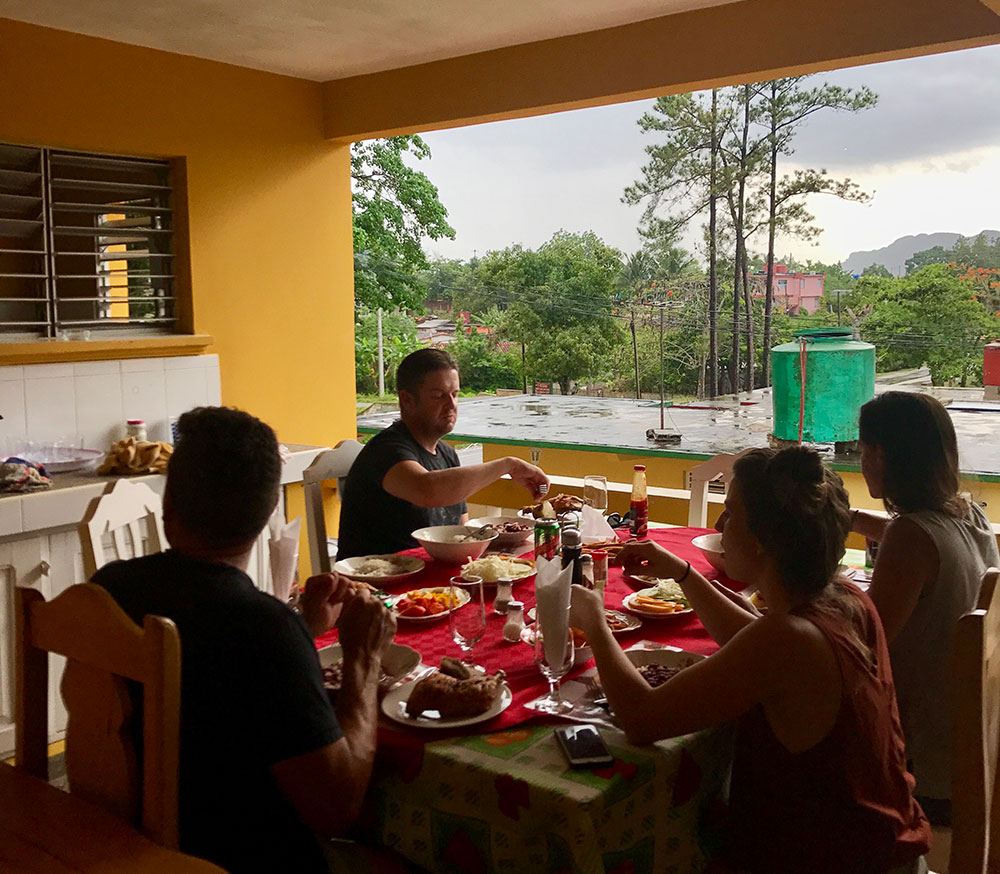
An incredible fried chicken dinner at Juany and Daniels, our casa particulares in Viñales, Cuba. We kept peeking into the kitchen to see how they fried chicken so well…it’s really better than anything you will find in the States!
5. Best Places to Eat in Cuba
As Americans traveling through Cuba, we learned the best place to eat in Cuba is at home. And most hosts can arrange for you to have meals at your rental house or apartment. I highly recommend organizing this in advance. Who doesn’t want a personal chef preparing your breakfast, lunch, and dinner? This is also important as there are no large grocery stores in Cuba. Cubans still have the Libreta, a socialist food ration system, in place.
The markets will have dry goods, and some may sell chicken or pork when available, however, it was hard to find dairy products, fresh fruits, or vegetables. As a bonus, the food served at your casa particulares far exceeds what you will find at a government-run restaurant. In addition, you will get to practice your Spanish, and you can often have your host arrange transportation or book activities for you during each meal.
Furthermore, if you do plan to go out in Cuba, the hotel restaurants are often your best bet!
Meals are inexpensive in Cuba compared to the U.S. As Americans traveling in Cuba, we spent less than $5 (U.S. dollars) per person on breakfast at our accommodations. And this included fresh bread, coffee, eggs, ham, cheese, and a freshly squeezed juice or smoothie. Dinner was $10-15 (U.S. dollars) and often included chicken or fish, vegetables, rice, and dessert!
Dine out at a paladares. Privately-run restaurants are becoming more popular in Cuba. And will serve you much more than the meat, rice, and beans you may find at a government-run establishment. Once again, the entrepreneurial spirit shines through. We had some of the best meals at local, family-owned paladares throughout Cuba.
The pollo frito or fried chicken at one spot was the best I’ve ever eaten. In addition, $15 often bought a lobster tail dinner, which rivaled the Puerto Nuevo-style lobster we are used to on the West Coast!
Have a piña colada…and a daiquiri! There is nothing better on a hot day than to return from your hike or stroll through town and having an ice-cold piña colada to cool off. After a day of rock climbing, we often enjoyed one or two Cristals or Bucañeros, the local cervezas, at Raul’s farm.
From day to day, Raul also whipped up some of the tastiest piña coladas we’ve ever had. The blended cocktails and juices are truly made from the freshest ingredients! And if you did not know, Cuba is the home of the Daiquiri. Rumors are that Hemmingway helped perfect this concoction at his favorite watering hole, La Floridita!
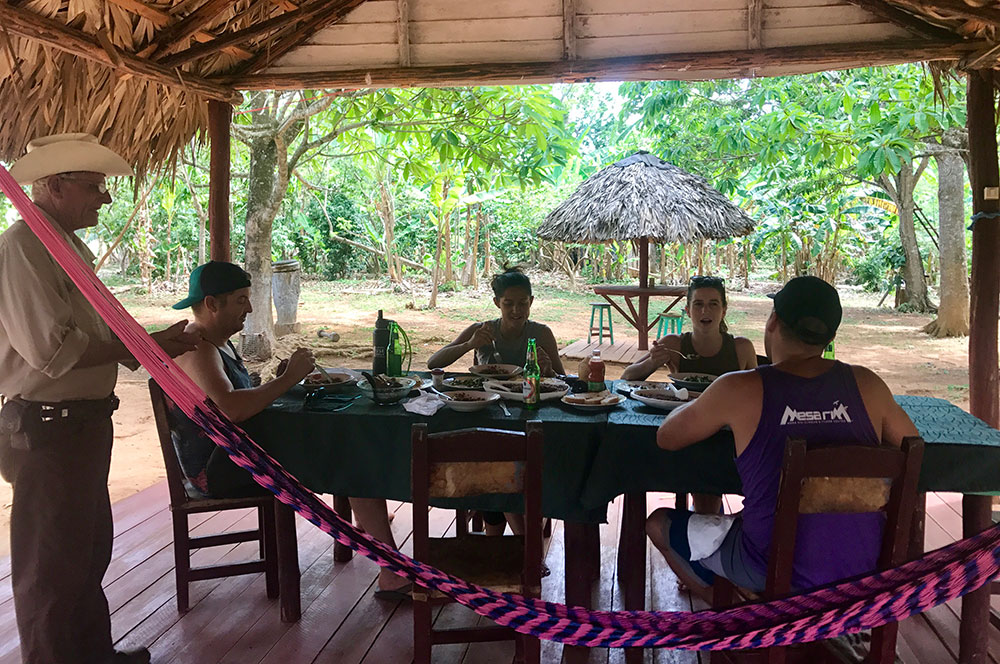
Lunch at Raul’s Farm in Viñales, Cuba where we were treated to delicious barbacoa and cervezas after a long day of hiking and rock climbing!
6. Americans Traveling in Cuba: Exchanging U.S. Dollars
Cash is king when traveling as an American in Cuba. American credit cards and debit cards may not work in Cuba. Even if you did have a credit card set up in Mexico or Canada, good luck trying to find someplace to use it.
Plan in advance how much money you will need for each day. We budgeted $100 per person per day in Cuba after accommodations were paid for. Prices are much lower in Cuba than in the U.S., especially if you eat most of your meals at your accommodations, or outside of the major tourist areas!
Always check the current exchange rate for the Cuban Peso (CUP) with the American dollar. In addition, there is a service charge for exchanging American dollars, almost 13%!! We changed our cash at the airport in Havana when we incurred this service charge. Since Cuban pesos are not traded internationally, you cannot buy them outside of Cuba.
You can also exchange money at your hotel, a CADECA or Casa de Cambio in major cities. Keep in mind, you are also prohibited from bringing Cuban pesos outside of Cuba. Definitely buy your last souvenirs and exchange any remaining Cuban pesos for dollars (if you can) before you fly out!
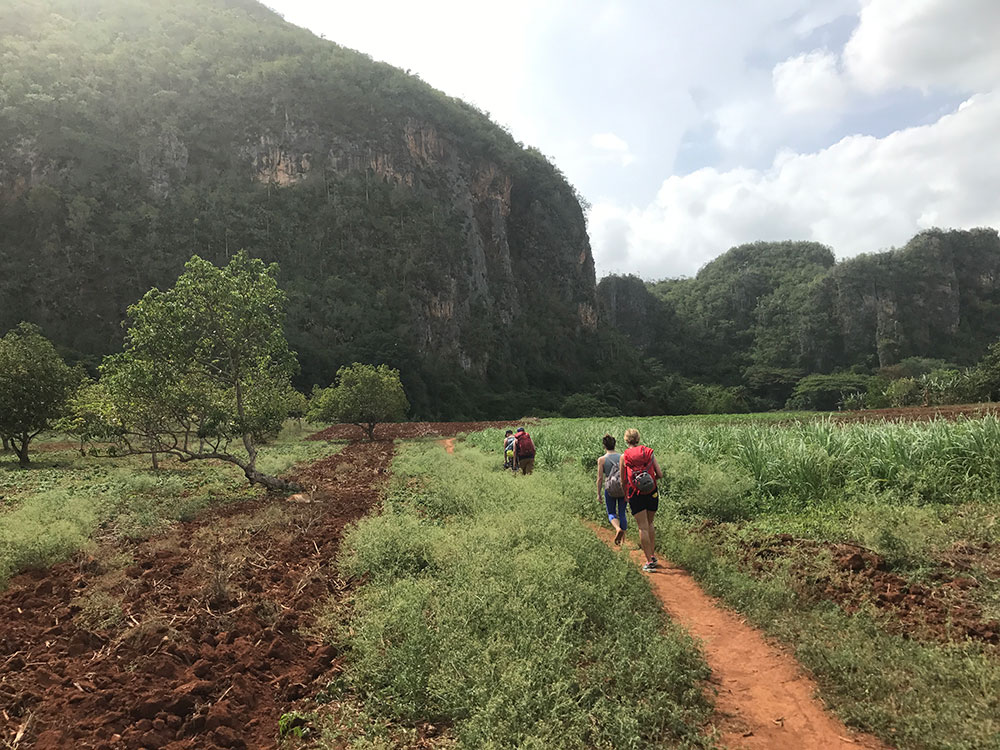
Hiking through Raul’s Farm to Mogote del Valle, one of several rock climbing areas in Viñales, Cuba.
7. Rock Climbing In Cuba, What Americans can expect
Early into our Cuba trip planning, I began emailing Armando Menocal, co-author of the Cuba Climbing guidebook, and the man that helped put Cuba on the map for rock climbing. We were planning to donate rock climbing gear, along with gear to bolt new routes. Access to climbing equipment is rare in Cuba. There are no outdoor gear shops like an REI or rock climbing gyms as you might find in America.
What’s the rock like? The rock climbing in Cuba is on beautiful, yet jagged formations of limestone. And the climbing is mostly around the agricultural farms in the Viñales Valley. Even if you’re not a climber, this area is beautiful for hiking!
Traveling to Viñales Valley in Cuba to Rock Climb
The Viñales Valley is a UNESCO World Heritage site, and the geology in this part of the country, known as a karst landscape, is fascinating. You will find everything from hidden caverns with stalactites, to giant tufas and jungle-covered mogotes! The routes are well-bolted, and a 60-meter rope, slings, and a dozen quickdraws will do. A trad rack is definitely not necessary. However, a helmet, headlamps, sunscreen, and mosquito repellant are essential!
Plan on a 2-3 hour taxi ride to reach the town of Viñales, located in the Western part of Cuba in the Piñar del Rio province. And arrange accommodations beforehand as the town is very small. There are no large hotels nearby.
Once settled into your accommodation, you can strap on your backpack and enjoy a nice stroll through town. We picked up water for our Camelbaks at the grocery store before heading out to Raul’s Farm. Plan on an easy 30-minute walk along dirt roads, depending on where your accommodations are in town, to reach Raul’s farm. Remember Cuba is a hot, tropical destination, so be prepared for heat, and also afternoon thunderstorms!
The Cuba Climbing Guidebook gives you all the climbing beta for the area. Along with plenty of maps to make your way around. Raul and his staff that run the farm were incredibly accommodating, offering us snacks on our way to climb, and cervezas on the way back! Bring small bills, in Cuban pesos, to ensure you can buy your crew piña coladas to celebrate the day. Then lie back in one of Raul’s hammocks to catch the sunset over the Viñales Valley.
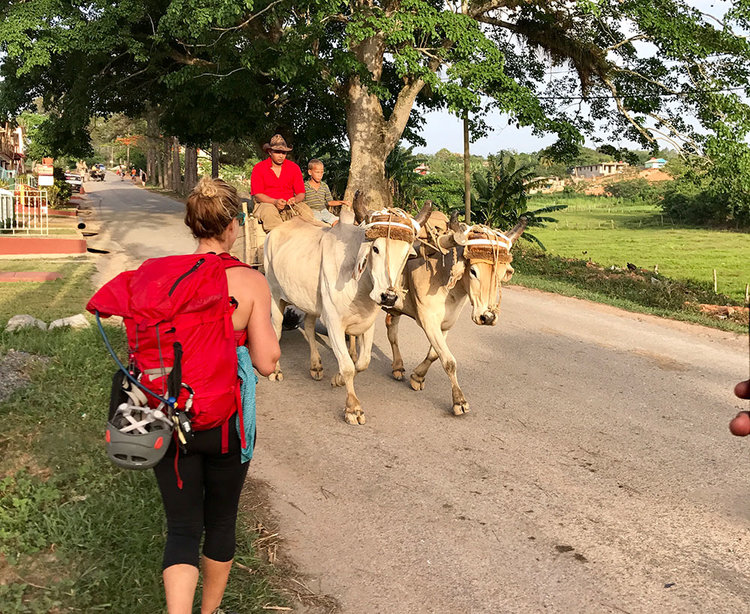
Inland from Havana in the town of Viñales, you’ll be surrounded by farmland. And it is not uncommon to see oxen pulling a cart down the street here!
8. Bringing Home a Cuban Cigar to America
Yes, as an American traveling to Cuba, you can bring that Cohiba back home! Cuban cigars are inexpensive and easily found throughout Cuba. Raul, the local farmer who provided meals as well as access to the best climbing in Cuba, hand-rolled his own and sold them, 2 for $1!! Quite the bargain.
In addition to Cuban cigars, you can also bring home rum on your trip back to the U.S. If you are not sure about a particular item, check first before packing it. A quick tip: Cuban cigars help keep the mosquitos at bay in the warm, rainy season. We would light several at our climbing base camp, or while hiking through the jungle!
9. Other Activities to Do While Traveling in Cuba
Touring Old Havana will easily take up a full day, maybe two! There are so many cool hotels, bars, and artwork. And just walking the malecón or being driven around in a vintage convertible is a great way to see Havana! If you have more time, visit the local Cuban beaches outside of Havana near Playas del Este where you can snorkel. And if you just want a nice beach and lots of caipirinhas, daiquiris, or piña coladas delivered to your palapa, Varadero is the spot!
Want even more of the colonial city culture? Head inland to Trinidad, another UNESCO World Heritage Site!
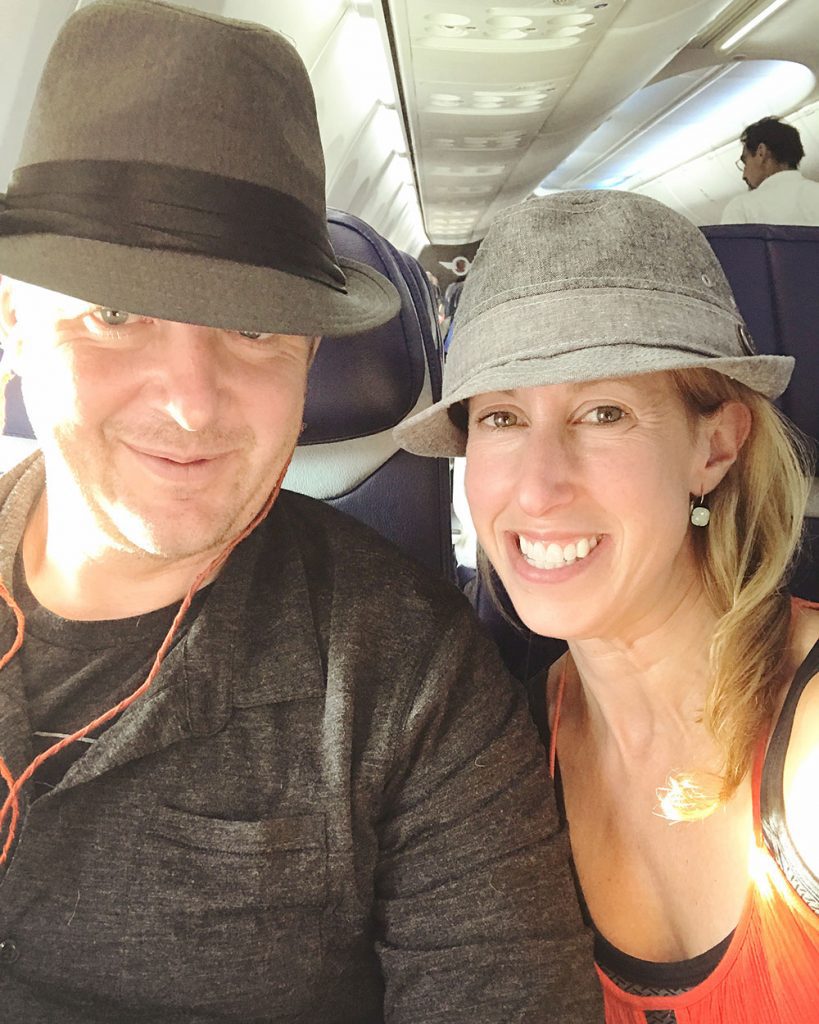
My fearless travel companion and I finally en route to Havana, Cuba!
Final Thoughts on Americans Traveling to Cuba
Somewhere in the Everglades in Florida, squished into the back of that Dodge Charger, I decided a blog post about Americans traveling to Cuba was in order. No, it was not due to the hectic start of our Cuban trip!
It was because I knew that these moments are precious. With jobs, kids, and all the other things that keep us busy, it’s not very often that we can rally our best friends and adventure buddies for a trip. And these travels also yield some of the greatest memories. They fill our late nights with tales of well-laid plans gone awry!
Below are more resources to help you plan your trip to Cuba:
- Traveling To Cuba– U.S. Embassy
- Cuba Climbing Guidebook
- Smithsonian Journeys
- Cuba Educational Travel
- Center for Cuban Studies
For more photos and fun facts about our outdoor adventures, check out Top Rope Media’s Facebook and Instagram pages. Or check out some of our other travel blogs:
Until next time, ¡Hasta luego!
Meredith McConvill, Top Rope Media
Such a bummer, I’ve always wanted to go there! Hope it becomes easier in the future.